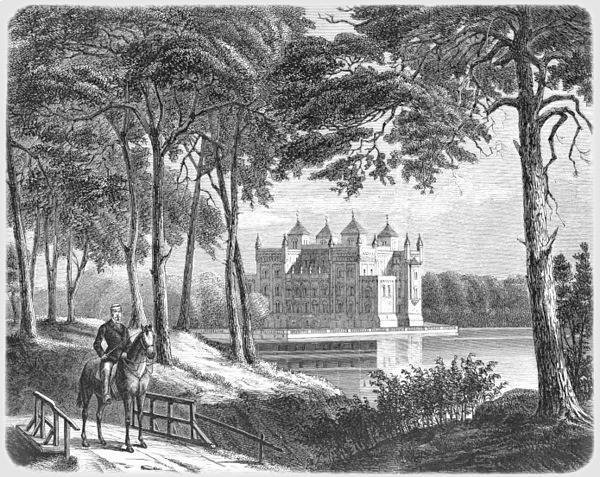The History of Stora Sundby
1200-talet var århundradet då inkariket grundlades, korsfararna erövrade Konstantinopel och Marco Polo kastade loss mot Kina. Det är också då historien om slottet Stora Sundby tar sin början. Det började med ett enklare försvarsverk, strategiskt placerat vid Hjälmaresund, vars grund fortfarande finns att beskåda i ekparken intill slottet. Borgen omnämns tidigt och man vet att den bland annat belägrades 1364 av Albrekt av Mecklenburg som låg i strid med Magnus Eriksson om att bli Sveriges kung. Under 1400-talet övergavs den gamla borgen och en ny uppfördes på den plats där slottet står idag, vackert belägen vid Hjälmarens strandkant.

The new castle was completed in the mid-16th century and went by the name of Sundby House. Through marriage, the castle at this time belonged to the influential Sparre family, who would come to own it for more than three centuries. The Sundby House-branch of the Sparre family died out in the early 19th century and shortly afterwards the castle and its estate were purchased by Count Carl De Geer. His wife Ulrika was rather underwhelmed by the old castle. Like many women of the age, she read Sir Walter Scott’s novels about the noble knight Ivanhoe and she is said to have told her husband firmly: “I want a romantic medieval castle on the banks of Hjälmaren”. As luck would have it, Count De Geer was one of Sweden’s wealthiest men and one can assume that he loved his wife deeply, thus drawings of Sundby House were soon dispatched across the North Sea to architect Peter Frederick Robinson – the same architect who designed Walter Scott’s own Abbotsford House in Scotland. The drawings were returned in a Neogothic style, complete with pinnacles and towers, and so the old Renaissance stronghold was transformed into a grand fairytale castle in the Norman vein. Master builder Abraham Nyström was commissioned to realise the plans, a task that would last 16 years. The majority of the old walls and interiors were preserved, with the main focus instead on cladding the old castle in new armour.
Sweden’s most beautiful castle was completed in 1848, now boasting four large towers symbolising the seasons, 12 smaller turrets for the months, 52 rooms for the weeks of the year, and 365 windows – one for each day in the calendar.
Stora Sundby today
Stora Sundby remains an inhabited castle to this day, and is now home to us, the Klingspor family, who have owned the estate since 1888. This was the year that Carl and Ulrika De Geer’s great grandchild, and thus the heiress of the estate, Louise Silvferschiöld, married Count Carl Klingspor. The castle was, however, leased for her lifetime to Countess Stephanie von Wedel and it was only upon her death in 1937 that we, the Klingspor family, moved in. Today, Stora Sundby is the home of Mauritz and Ida-Sofia Klingspor. With a light touch and great sensitivity to the history of the place, large parts of the building have been adapted to meet today’s standards of comfort. The guest rooms have largely been preserved since the time of the De Geers and Countess von Wedel, although modern bathrooms have been incorporated discreetly. Despite the large spaces and the castle’s splendid grandeur, we have managed to create a living home with a welcoming atmosphere that is much appreciated by our visitors.
A living castle on a living estate
Those of us who live at Stora Sundby are keen to keep the castle and the estate alive. The preservation of cultural and historical assets is of great importance, and a huge responsibility that forms a natural part of daily life on the estate. In addition to maintaining the castle and its accompanying buildings, we work actively with nature conservation and gamekeeping to promote a richly diversified flora and fauna. A fence has been erected around the oak parkland adjacent to the castle, where fallow deer and mouflon sheep help us to keep the historical landscape open. The forests across the estate have good stocks of moose, red deer and wild boar, and we have created a wide range of ponds, wetlands and shelter planting to promote rich birdlife.
Stora Sundby comprises 3,700 hectares in total, of which forest makes up 3,000, arable land accounts for 450 hectares and the rest is other land. There are also 1,450 hectares of water in Lake Hjälmaren that are professionally fished. Since 2014, we also own and run nearby Biby Gård, a estate of around 1,000 hectares, and two smaller farms of around 270 hectares. The estate earns its keep primarily through forestry with the production of timber and pulpwood, the farming of pasture and willow, and management of 70 or so residences and holiday homes, rental premises, tenancies, boat moorings and so on. The estate also has an extensive shooting and hunting business that comprises two parts: one or two-day shoots, often combined with exclusive accommodation at the castle, and hunts over several days that are usually combined with self-catering lodgings.
